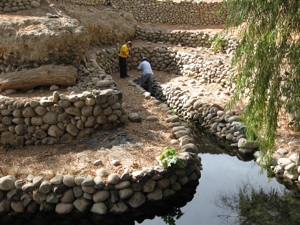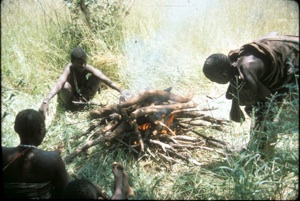Margaret Schoeninger - Projects
Projects

Research interests:
Diet reconstruction based on the stable isotope ratios of carbon, nitrogen, and oxygen in organic (bone collagen, hair, fingernails, muscle, etc.) and inorganic (bone mineral, tooth enamel) tissues.
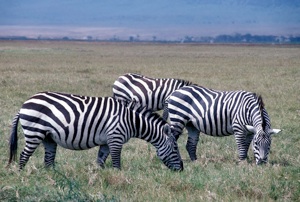
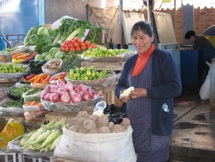
Present projects include:
Extant human forager diets – Alyssa Crittenden
The Dani of Western Papua New Guinea – with Professor Phillip Walker (now deceased Professor UCSB), graduate student Andrew Somerville (link) and undergraduate student Susan Walters (link) – The Mulia Dani of Western New Guinea, Indonesia were in the midst of major cultural change when in the late 1950’s Christian missionaries entered the region. We explore how the arrival of missionaries and the establishment of a small settlement with an airstrip affected the Dani. Their traditional diet consisted mainly of sweet potatoes. They ate pig meat infrequently. Our stable isotope analysis (δ13C and δ15N) of Dani hair collected in this early period from several villages in the region suggests differential access to imported foods. The δ15N values are extremely low for human populations and we are currently investigating the δ15N of their foods as well as metabolic adaptations of humans eating low protein diets. In addition to learning more about the Dani, our results provide information on possible diets in early members of our lineage, which changed from a basic primate diet of fruit (low δ15N) and leaves (low δ15N) to one including animal foods (high δ15N).

δ13C endpoints for diet determinations in early hominins – with graduate student Melanie Beasley, graduate student Andy Froehle, former postdoctoral scholar Dr. Corina Kellner (now on faculty at Northern Arizona University) – commonly the endpoints for estimating the amount of C3 and C4 foods in human and fossil hominin diets are based on comparisons with browsing and grazing fauna. Yet, these species rely on extensive fermentation within their fore or hind-guts. Humans, in contrast, rely largely on enzymatic metabolism with less emphasis on fermentation in the hind-gut. Our group has performed meta-analyses of published δ13C data from bone collagen and apatite of experimental fauna (Kellner and Schoeninger, 2007) and established that large bodied species with simple guts have values similar to small bodied species fed diets with the same δ13C values (Froehle et al., 2010). Now, we investigate the added information provided by δ15N values in a three-variable model and compare the relationship of δ13C values in bone collagen and apatite in free-ranging browsers and grazers of small and large body size collected in a single region of northern Kenya.
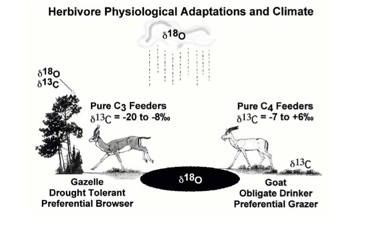
Paleoecology in the Levant: Neandertals and Anatomically Modern Humans – with Professor Henry Schwarcz (McMaster University) and Kris Hallin (former graduate student at The University of Wisconsin, Madison and now in the US Army) – These two human groups are morphologically distinct and use similar tools in the Levant during the last Interglacial and last glacial periods. Yet, the collection of fauna hunted differs in sites attributed to each group. Does this indicate cognitive differences between the groups as some have suggested or could there be an ecological explanation? We investigated this question using δ13C and δ18O from dental enamel sampled sequentially in single molar teeth of goats and gazelles. These two species serve as proxy monitors of humidity, rainfall amounts and patterns, and general habitat ecology.
Prehistoric Nasca of southern coastal Peru – with former postdoctoral fellow, Corina Kellner (Northern Arizona Unversity), former graduate student, Erin Henry, and graduate student Andrew Somerville – This project, headed by Dr. Kellner, explores the development of social complexity within the Nasca (Kellner and Schoeninger, 2008) and the effects of incursion by the imperial Wari from highland Peru. First, we examine the potential effects on agricultural intensification and evaluate the potential presence of envoys from the Wari heartland.
The diets of living savanna baboons and chimpanzees compared to savanna dwelling human foragers – with Professors Jim Moore (emeritus, UCSD), Shirley Strum (UCSD) and Peter Ditchfield (Cambridge University), and former graduate student, Alyssa Crittenden (now postdoctoral fellow at UCSD Medical School) and undergraduates Chrisandra Kufeldt and Damien Salvaggio (both UCSD now at George Washington University and Teach For America) - all these groups rely on foods collected in savanna habitats of east Africa. All are generalist feeders; but they emphasize a different suite of diet items. Are these differences recorded by δ13C values in their hair, skeleton, and feces? These data complement others collected in different habitats of East and South Africa.
